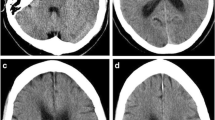Abstract
Edema is an important part of the pathophysiology of stroke. However, it remains unclear how brain swelling may influence the progression and measurement of infarction after cerebral ischemia. Initial studies in a mouse model of transient middle cerebral artery occlusion demonstrated that infarction grew from 24 to 72 h after stroke onset. Comparison of 24-h versus 72-h brains suggested that tissue swelling developed in both infarcted and non-infarcted ipsilateral regions. Volumes of infarction differed, depending on the method of calculation: direct, indirect, or normalized. A simple first-order model was constructed dividing total brain into three subsets, comprising normal contralateral tissue, non-infarcted ipsilateral tissue, and infarcted ipsilateral tissue. Each subset was then defined as a ratio of original volumes plus additional swollen volumes. By changing the relative portion of swelling assigned to infarct versus non-infarct, our model demonstrated that direct, indirect, and normalized calculations led to different thresholds for matching absolute infarct volumes. In this proof-of-principle study, we described a mathematical model to simulate the distribution of brain swelling and infarct development over time. Our findings suggest that accurate quantitation of infarct volumes depends on relative distributions of edema that may occur in both infarcted as well as non-infarcted brain.




Similar content being viewed by others
References
del Zoppo GJ (2009) Inflammation and the neurovascular unit in the setting of focal cerebral ischemia. Neuroscience 158:972–982
Dirnagl U, Iadecola C, Moskowitz MA (1999) Pathobiology of ischemic stroke: an integrated view. Trends Neurosci 22:391–397
Lo EH, Dalkara T, Moskowitz MA (2003) Mechanisms, challenges and opportunities in stroke. Nat Rev Neurosci 4:399–415
Vosler PS, Chen J (2009) Potential molecular targets for translational stroke research. Stroke 40:S119–S120
Bardutzky J, Schwab S (2007) Antiedema therapy in ischemic stroke. Stroke 38:3084–3094
Hoff J, Keep R, Xi G, Hua Y (eds) (2006) Brain Edema XIII
Jin G, Tsuji K, Xing C, Yang YG, Wang X, Lo EH (2009) CD47 gene knockout protects against transient focal cerebral ischemia in mice. Exp Neurol 217:165–170
Lin TN, Yong YH, Wa G, Khan M, Hsu CY (1993) Effect of brain edema on infarct volume in a focal ischemia model in rats. Stroke 24:117–121
Swanson RA, Morton MT, Tsao-Wu G, Savalos RA, Davidson C, Sharp FR (1990) A semiautomated method for measuring brain infarct volume. J Cereb Blood Flow Metab 10:290–293
Takano K, Tatlisumak T, Formato JE, Carano RA, Bergmann AG, Pullan LM, Bare TM, Sotak CH, Fisher M (1997) Glycine site antagonist attenuates infarct size in experimental focal ischemia. Postmortem and diffusion mapping studies. Stroke 28:1255–1262; discussion 1263
Klatzo I (1987) Pathophysiological aspects of brain edema. Acta Neuropathol 72:236–239
Kimelberg HK (1995) Current concepts of brain edema: review of laboratory investigations. J Neurosurg 83:1051–1059
Simard JM, Kent TA, Chen M, Tarasov KV, Gerzanich V (2007) Brain oedema in focal ischaemia: molecular pathophysiology and theoretical implications. Lancet Neurol 6:258–268
Manley GT, Binder DK, Papadopoulos MC, Verkman AS (2004) New insights into water transport and edema in the central nervous system from phenotype analysis of aquaporin-4 null mice. Neuroscience 129:983–991
Zhang Y, Zhang H, Feustel PJ, Kimelberg HK (2008) DCPIB, a specific inhibitor of volume regulated anion channels (VRACs), reduces infarct size in MCAo and the release of glutamate in the ischemic cortical penumbra. Exp Neurol 210:514–520
Rosenberg GA (2002) Matrix metalloproteinases in neuroinflammation. Glia 39:279–291
Simard JM, Yurovsky V, Tsymbalyuk N, Melnichenko L, Ivanova S, Gerzanich V (2009) Protective effect of delayed treatment with low-dose glibenclamide in three models of ischemic stroke. Stroke 40:604–609
Acknowledgments
This study is supported in part by grants from the NIH and the AHA.
Author information
Authors and Affiliations
Corresponding author
Rights and permissions
About this article
Cite this article
Jin, G., Sun, P.Z., Singhal, A.B. et al. First-Order Mathematical Modeling of Brain Swelling in Focal Cerebral Ischemia. Transl. Stroke Res. 1, 65–70 (2010). https://doi.org/10.1007/s12975-009-0009-5
Received:
Revised:
Accepted:
Published:
Issue Date:
DOI: https://doi.org/10.1007/s12975-009-0009-5




